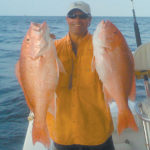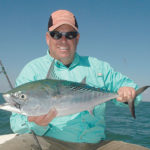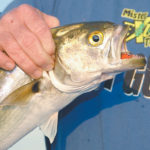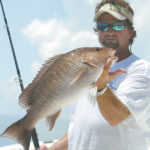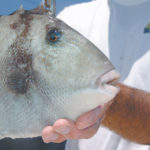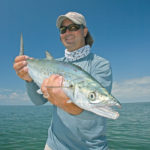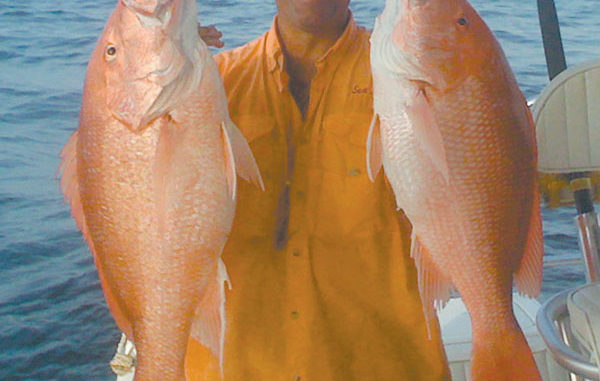
Nearshore rigs hold best summertime action
“It’s a bird!” gasped Eddie while pointing up. “No! It’s a plane! No! It’s a PIG!”
We all looked skyward but saw nothing.
“Who’d a thought two beers would induce hallucinations?” Doc shrugged as he pointed at Eddie, who was now pointing at Pelayo, who was busily (could it be?) clearing the picnic tables of crawfish heads and shells!
The women, especially, gaped at the spectacle. Priscilla and Trisha, made pink-cheeked and mellow from chardonnay, had patched up their ritual weekly spat, and walked over together for a closer look at the clean-up man.
“Ah!” blurted Chris. “I think I get it. Pigs are flying ’cause Pelayo’s cleaning up after himself.”
In fact, he was voluntarily cleaning up after most of Doc’s crawfish-boil guests. Dragging the same big plastic tub in which we’d purged them earlier, Pelayo was now sweeping the tables clean and filling the tub with the piles of heads and peeled tails, while dutifully separating the garlic, corn and potatoes and piling them back on the table.
“Y’all slip into your boots and get ready,” Pelayo looked over while wiping the crawfish juice off his arms. “Almost time for some crawdad-stompin’, kinda like grape-stomping for wine, but with boots.
“Didn’t you and Spencer partake of some grape stomping on your last European cruise, Priscilla? Seems like we heard the story more than once.”
Pelayo grinned heavily at Priscilla who pretended not to hear.
“Kinda like Lucy!” laughed Trisha. “Yeah, I remember her stomping grapes.”
Pelayo finished the table clearing, and was soon walking back from Doc’s garage carrying three pairs of white shrimp boots.
“Let’s get stomping,” he said while slipping one on.
“You’re not gonna actually eat anything you make with those crushed heads?” asked a grimacing Priscilla.
“Heck no,” answered Pelayo, “but the fish will — cheapest chum around!”
And with that he jumped into the tub and started stomping and crushing.
“Come on in!” he waved. “See, if you just dump this stuff overboard, the heads float and they’re not quite as effective. This way the little pieces sink. Soon you got a feeding frenzy of mangroves, sheepshead, Spanish, pompano, triggerfish, spadefish, bluefish, even red snapper around your boat. And without bashing yourself silly and bankrupting yourself on some 20-mile offshore haul. With the help of this chum, we’ll easily fill a box at the shallower rigs, barely 8 miles offshore.”
Pelayo was aiming his discourse as much to the out-of-town guests as to Doc himself, a traditionalist in Louisiana offshore fishing, which means his trips feature long butt-bashing hauls, ponderous tackle and hit-or-miss bottom fishing for snapper, grouper and AJs.
We prefer short hauls, casting shrimp and squid-sweetened jigs on medium spinning tackle, and returning with boxes full of the mixed fish Pelayo mentioned above. All swarm around our shallower rigs, all slam shrimp or squid-tipped jigs, all then provide spool-sizzling, muscle-cramping action on medium spinning tackle. And all can be rendered delectable either on the grill or in the pan (yes, even the bluefish).
Doc’s nephew Tobias (Toby) was in from Clearwater, Fla., his post-Tigertown habitat. Overhearing our discussion, he rushed over wide-eyed. Catching fish like Spanish mackerel, triggerfish, spadefish and the rest basically for the casting really had him pumped. Around Florida, these are “extremely elusive game fish,” to say nothing of “prized table-fare.”
A Florida fishing guide who can consistently put his clients on a mess of triggerfish or even “a brace” of Spanish mackerel walks tall in Florida. (Stop snickering all you Louisiana fishing guides.) Toby jumped at the chance to come along on the morning trip to the West Delta 30s and 40s.
And what luck. A shrimp boat was anchored near the mouth of the Empire Canal, culling his catch.
“Let’s pull over,” I motioned to Pelayo. “And get some bait and some more chum.”
Some of this shrimper’s “bycatch” wouldn’t go to waste. All those little croakers, pogies, eels and stuff serve as superb additional chum as well as bait itself when we go offshore. Nothing beats a live croaker (or cocaho or pinfish or any small fish) for mangroves. But unlike most big specks, small mangroves also inhale free-lined deceased croakers and pogies.
Oh sure, I know. You can buy similar stuff for bait chum that’s shipped down from Rhode Island or California. It comes in nice little boxes or bags. Figure that one out: We catch a hundred times as much and shovel it over for the seagulls. Up north, they package it and sell it to us!
We hit the Gulf, and all looked at each other wide-eyed and gaping. The weather forecast had been RIGHT!!! — 1- to 3-foot seas! We skimmed easily over the gentle swells. Toby was in the bow, wind in his face, taking in the scenery. About five miles out, he suddenly pointed.
“What’s that?!”
Something was in a feeding frenzy, the water erupting, seagulls hovering above.
“Probably little tunny,” Pelayo said while idling over. “Maybe Spanish. Maybe both!”
Toby was already reaching for his rod.
“Man those things FIGHT!” he beamed while casting toward the splashes with the same white beetle we’d used inshore the previous weekend. On the third crank, Toby almost went overboard.
“WHOOOA!” he yelled as he reared back and his spool started emptying.
“Gotta be a little tunny, Toby! Now tighten that drag!” Pelayo yelled. “We’ll follow it!”
And off we went. Toby would crank it in, but as soon as we stopped, the thing zoomed off again. He fought the creature for 10 minutes, and I finally netted the little tunny. Toby was ecstatic. Pouring sweat but beaming. We only had two more miles to go. In minutes, we tied up to a rig, at WD 31s, and — hallelujah! — the gentle breeze carried us right under the shade. Perfect.
The depth-finder showed 48-foot depths. And the very conditions that would make inside fishing tough today made them ideal offshore. A slack tide inside means a slack current out here, hence your bait or jig stays close to the beams, where the fish hang out. Scuba diving under the rigs has taught us that most of the fish around a platform tend to concentrate on the upcurrent side of the rig.
A study by the Coastal Fisheries Institute even confirmed our observations. CFI scientists dropped a contraption under rigs that takes sonar pictures of what’s down there, and monitored the pictures for 20 months. Yep, most of the blips were on the upcurrent side. A slack current makes this less of an issue.
Also, with a slack current, the chum sticks around, rather than getting carried away and scattered.
The water was dark green, and Toby flipped out looking down around the beams.
“What’s all THOSE!” he said as he pointed and jerked his head around.
“All kinda stuff, Toby!” Chris laughed. “Sheepshead, spadefish, mangrove snapper, jacks. Put some shrimp on that jig, and get it out there. Ain’t no telling what’ll clobber it!”
“And out there!” Toby pointed at another feeding frenzy behind us as he baited up. “What’s…?”
“Now THAT’S Spanish!” Pelayo nodded. “I can see ’em jumpin’ straight out da wawda!”
Toby looked like he’d been plugged into a socket. He was beaming, quivering, frantic. While Chris went bottomward with a ponderous Carolina rig and whole croaker to start on his red snapper limit, Toby cast out with his white beetle (Spanish seem to smack silver and white jigs best, not to mention spoons, but with those line-cutting teeth, fishing with spoons for Spanish can get expensive) while I went to work on the bycatch to add to the crawfish chum.
Soon I had a nice bucket of chum, and Toby and Pelayo were battling those aquatic missiles known as Spanish mackerel, their spools screaming, their rods bent into beautiful U’s.
“WOW!” was all Toby could manage as he held on with a crazy grin. Chris was right beside him, grunting and pumping away as his rod smashed the gunwale bar. Soon you could see the appetizing pink-red through the water below as Chris tightened his drag and made some headway into half his red snapper limit.
I chunked out the chum and watched it drifting through the clear green water as Chris hauled out and swung aboard a gorgeous red snapper.
“Let’s get these limits out of the way first,” he laughed. “Won’t take long!”
Indeed, the consensus among rig divers especially is that the swarms of red snapper around our rigs (even the shallower ones) the past few years surpass anything we’ve seen for at least two decades. Kinda like the duck limits I guess. Remember those three-duck limits and short seasons back in the early ’90s? Remember how ducks darkened our skies and limits came in minutes back then? Then the limits shot up to six and the season to 60 days. And for most of us, it’s a struggle to get half a limit! Same principle with red snapper — but the history reversed.
“Lemme get the net for that one, Toby!” I howled when I spotted the size of his Spanish.
These mackerel hang at our shallower rigs all year long, but we always do best in mid summer, catching the biggest during this time. They’re spawning this time of year. The big ones we catch (the 3- to 5-pounders) are all laden with eggs. I’ll put a 2-pound Spanish against an 8-pound trout anyday (not that I’ve ever caught a speck that size).
Also, in winter/spring, you get your line snapped twice for every Spanish you actually boat. What happens is, while you’re fighting one, another in the school grabs the swivel on your leader that’s twirling around or just grabs the line out in front of it.
On the other hand, in the summer, Spanish aren’t schooled up as tight. The individual fish are much bigger and more spaced out, not in tight schools. It’s the ideal time to battle them one on one.
I netted Toby’s Spanish as he whooped and high-fived with Chris. In Florida, this trip would have already been a rollicking success. The Times-Picayune Creole Cookbook, c. 1911, spoke highly of Spanish mackerel: “A delicate and delicious fish far superior to any mackerel in the world — on equal footing with the pompano.”
Toby’s Spanish was spattering me with blood and slime during the unhooking process when I looked overboard and saw that we had a fish fiesta below us. I could make out several mangroves in the darting, flashing, slashing melee of mostly spadefish, hardtails, sheepshead and clumsy triggerfsh. Pelayo freelined a little bycatch croaker into it and — WHAM! — the brawl started. The thing was going nuts, but heading inside the rig.
“Bet it’s a mangrove!” Pelayo yelled while tightening his drag. “They always do this — head straight for the beams. Gotta tighten this drag, and horse him out!”
Toby followed Pelayo’s lead (a plain hook, 50-pound fluorocarbon leader without swivel and a free-lined croaker), and was soon tussling with another mangrove.
“These things FIGHT, man!” he gasped as his biceps bulged, and he cranked away.
Amazingly, they both managed to horse their mangroves away from the beams, and we landed both.
I went down with a shrimp-tipped, small-hooked jig (pompano, triggerfish and spadefish all have small mouths), and in minutes I was swinging aboard a delectable triggerfish.
“Now HERE’S some eating!” I howled.
Toby lost his next mangrove to the barnacle-encrusted beams, and re-rigged with a shrimped-up jig as Pelayo boated a nice bluefish that had grabbed another freelined deceased croaker. Toby dropped his jig, let out about 20 feet of line, and had his pole doubled over in seconds.
“Fighting like another Spanish!” he roared.
I looked down through the water and saw the tell-tale yellow fins and shiny body.
“Hey, wait a minute!” I yelled. “That looks like … like … like A POMPANO!” Then I turned to Toby. “No better eatin’ fish out here, my man! You’ll see tonight!”
Toby seemed unimpressed. He wasn’t much thinking the eating part. The fighting part is what had him worked up.
Pompano are crustacean — not fish — eaters. So forget any lure that mimics a small fish. Jigs heads (with the smallest hook available) are best, but always tipped with shrimp — always. We favor shad rigs, however. But not so much the ones out now called “Speck Rigs,” which have a large hook, as befits a speck’s mouth. The original shad rigs are best — the ones with the tiny hooks that we used to catch croakers and channel mullet as kids.
I followed suit and dropped the jig about 20 feet down. Bump-bump — WHAM! And I jerked up.
“We’re ON ’EM!” I howled as my rod dipped and I started cranking.
This sucker was battling it out, too.
It was a spadefish. Chris had limited out on red snapper, switched to a small-hooked jig and was slugging it out with another spadefish from the stern.
“Perfect for the grill!” he beamed while finally holding it aloft.
I unhooked the spadefish, and re-baited my small-hooked jig, but with a little chunk of cut hardtail (from one Toby had caught to delighted whoops) this time, and hooked through the skin. Triggerfish are nibblers more than strikers, and notorious bait thieves. A hardtail chunk stays on much longer than a chunk of shrimp. And with this one, I caught a triggerfish and a Spanish that smacked right at boatside on a fast retrieve.
Our ice chest filled while our tackle box emptied. Deceased croakers yielded mangroves, Spanish and blues. Shrimp-tipped jigs yielded triggerfish, pompano and spades.
The action was frantic and non-stop. Toby — in his own words — had the fishing trip of his life.
“I can’t believe this!” he kept laughing and shaking his head. “Fish literally on every cast!”
And the amazing thing is, we didn’t see another boat, though we saw several passing us on their way farther out.
